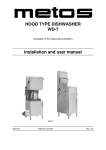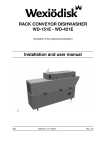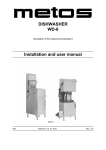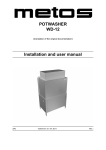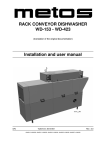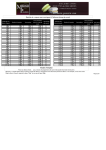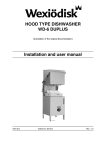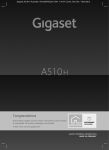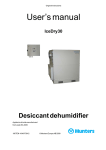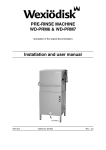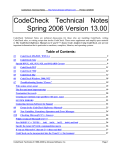Download Downloaden
Transcript
POTWASHER WITH GRANULATE WD100GR (translation of the original documentation) Installation and user manual S/N: Valid from: 01.05.2012 Rev.: 3.0 WD-100GR Rev. 1. General information ......................................................................... 1 1.1 Symbols used in this manual ........................................................................... 1 1.2 Symbols on the dishwasher ............................................................................. 1 1.2.1 Machine marking ...................................................................................... 2 1.3 Checking that the machine and the manual correspond .................................. 2 2. Safety instructions ........................................................................... 3 2.1 General information ......................................................................................... 3 2.2 Transport .......................................................................................................... 2.3 Installation ........................................................................................................ 2.4 Detergent and drying agent ............................................................................. 2.5 Operation ......................................................................................................... 3 3 4 4 2.5.1 Hot water .................................................................................................. 2.5.2 Crushing risk ............................................................................................. 2.5.3 Risk of slipping .......................................................................................... 2.6 Cleaning ........................................................................................................... 2.6.1 Pressure washing ..................................................................................... 2.6.2 The outside of the machine ...................................................................... 2.6.3 Cleaning the floor ...................................................................................... 2.7 Repairing and servicing the dishwasher .......................................................... 4 4 4 4 4 5 5 5 2.7.1 Safety instructions if the machine is not functioning ................................. 5 2.8 Recycling the machine ..................................................................................... 5 3. Installation ........................................................................................ 6 3.1 General information ......................................................................................... 3.2 Requirements for the installation site ............................................................... 3.2.1 Lighting ..................................................................................................... 3.2.2 Ventilation ................................................................................................. 3.2.3 Drains ....................................................................................................... 3.2.4 Space for servicing ................................................................................... 3.3 Transport and storage ...................................................................................... 3.4 Preparing for the installation ............................................................................ 3.5 Unpacking ........................................................................................................ 6 6 6 6 6 7 7 7 8 3.5.1 Removing packaging ................................................................................ 8 3.6 Recycling the packaging .................................................................................. 9 3.7 Installation ........................................................................................................ 9 3.7.1 Positioning the machine ............................................................................ 9 1 WD-100GR Rev. 3.8 Connections ................................................................................................... 3.8.1 Electrical connection ............................................................................... 3.8.2 Water connection .................................................................................... 3.8.3 Drain connection ..................................................................................... 3.8.4 Ventilation ............................................................................................... 3.9 Installing auxiliary equipment ......................................................................... 3.10 Installing detergent and drying agent equipment ......................................... 3.10.1 Electrical connection of the equipment ................................................. 3.10.2 Detergent dosing system ...................................................................... 3.10.3 Drying agent dosing system ................................................................. 3.11 Trial operation .............................................................................................. 10 11 11 11 11 12 13 13 14 14 14 3.11.1 Start-up schedule .................................................................................. 14 3.12 Technical documentation ............................................................................. 16 4. Instructions for use ........................................................................ 17 4.1 Preparations ................................................................................................... 4.1.1 The machine's design ............................................................................. 4.1.2 Preparations before filling ....................................................................... 4.1.3 Filling the machine .................................................................................. 4.1.4 Positioning the items in the cassette ...................................................... 18 18 20 20 20 4.2 Using the machine ......................................................................................... 4.2.1 Washing .................................................................................................. 4.2.2 Starting the wash programme – washing ............................................... 4.2.3 Guaranteed final rinse ............................................................................ 4.2.4 Checking the washed items .................................................................... 4.2.5 Stopping the machine during operation .................................................. 4.2.6 Changing the water ................................................................................. 36 36 38 39 39 40 40 4.3 After use – cleaning ....................................................................................... 4.3.1 Daily cleaning ......................................................................................... 4.3.2 Periodic cleaning .................................................................................... 4.3.3 Periodic servicing .................................................................................... 4.3.4 Operating problems ................................................................................ 42 42 47 49 50 5. Technical information .................................................................... 53 2 WD-100GR Rev. 3.0 (201205) General information 1. General information Read the instructions in this manual carefully as they contain important information regarding the correct, effective and safe installation, use and servicing of the dishwasher. Keep this manual in a safe place so that it can be used by other operators of the dishwasher. The electronics in the machine are RoHS compatible. 1.1 Symbols used in this manual This symbol warns of situations where a safety risk may arise. The instructions given should be followed in order to prevent injury. This symbol on a component is a warning of electrical equipment. The machine is sensitive to electrostatic discharge (ESD), which is why a static electricity wristband must be used when handling the electronics. This symbol explains the correct way to perform a task in order to prevent poor results, damage to the dishwasher or hazardous situations. This symbol identifies recommendations and hints to help you to get the best performance from the machine. This symbol explains the importance of careful and regular cleaning of the machine to meet hygiene requirements. 1.2 Symbols on the dishwasher This symbol on a component is a warning of electrical equipment. The component may only be removed by a qualified electrician. The machine is sensitive to electrostatic discharge (ESD), which is why a static electricity wristband must be used when handling the electronics. 1 WD-100GR Rev. 3.0 (201205) General information 1.2.1 Machine marking The machine has two rating plates, one of which is placed at the bottom of one side of the machine and the other in the electrical cabinet. The technical information on the plates is also included on the machine's wiring diagram. The various rating fields show: Type 1 S/N: 2 5 V 6 M 9 kW 3 7 Hz 10 kW IP 4 8 A 11 kW Mårdvägen 4, S-352 45 V ÄXJÖ SWEDEN 1. 2. 3. 4. 5. 6. 7. 8. 9. 10. 11. 1.3 marks_SAP Machine type Machine serial number Year of manufacture Enclosure protection class Voltage Number of phases with or without zero Frequency Main fuse Motor output Electrical heat output Max. output Checking that the machine and the manual correspond Check that the type description on the rating plate corresponds with the type description on the front of the manual. If manuals are missing, it is possible to order new ones from the manufacturer or the local distributor. When ordering new manuals, it is important to quote the machine number found on the rating plates. 2 WD-100GR Rev. 3.0 (201205) Safety instructions 2. Safety instructions 2.1 General information The machine is CE marked, which means that it complies with the requirements of the EU machinery directive with regard to product safety. Product safety means that the design of the machine will prevent personal injury or damage to property. Modifying the equipment without the approval of the manufacturer invalidates the manufacturer’s product liability. To further improve safety during installation, operation and servicing, the operator and the personnel responsible for installing and servicing the machine should read the safety instructions carefully. Switch off the machine immediately in the event of a fault or malfunction. The machine must only be serviced by trained engineers. The regular checks described in the manual must be carried out in accordance with the instructions. The machine must be serviced by a person authorised to do so by the manufacturer. Use original spare parts. Contact an authorised service company to draw up a programme of preventative maintenance. Dangerous situations may arise if the instructions above are not followed. Before using the machine, ensure that personnel are given the necessary training in operating and maintaining the machine. 2.2 Transport Handle the machine with care during unloading and transport to avoid the risk of it tipping over. Never lift or move the machine without using the wooden packaging to support the stand. 2.3 Installation This symbol on a component is a warning of electrical equipment. The machine is sensitive to electrostatic discharge (ESD), which is why a static electricity wristband must be used when handling the electronics. Water and steam pipes must only be connected by authorised personnel. Water pipes must be connected in a way that complies with the current regulations of the local water supply authority. Check that the water and steam connections are tight before operating the machine. Make sure that the mains voltage is the same as that indicated on the machine's rating plate. The machine should be connected to a lockable mains switch. 3 WD-100GR Rev. 3.0 (201205) Safety instructions 2.4 Detergent and drying agent Only detergent and drying agent intended for industrial dishwashing machines must be used. Ordinary washing-up liquid must not be used in the machine or for soaking. Contact your detergent supplier regarding the choice of a suitable detergent. Be aware of the risk of handling washing and drying agents. Protective gloves and safety glasses should be used when handling dishwasher detergent. Read the warning text on the detergent and drying agent containers as well as the detergent supplier's regulations. 2.5 2.5.1 Operation Hot water The temperature of the wash and rinse water is 58°C and 85°C. Do not open the door until the wash and rinse phases have finished. 2.5.2 Crushing risk Take care when opening and closing the doors, as there is a risk of body parts being crushed between the door and the tank, and at the top of the machine between the door and the cover plate. 2.5.3 Risk of slipping In order to prevent the risk of people slipping if granulate has been spilled on the floor, this must be regularly swept up. Keep the floor dry and mop up any water which has been spilled. 2.6 Cleaning The temperature of the water in the tank is approx. 58°C and contains detergent. Be careful when draining and cleaning the tank. Use protective gloves. 2.6.1 Pressure washing The machine must not be cleaned with a pressure washer. If pressurised water is directed at the electrical cabinet, the water may penetrate the cabinet and damage the electrical equipment, which may affect the safety of the machine. In order to satisfy current requirements, electrical components of approved enclosure classes are used. There is no enclosure class capable of withstanding high pressure. 4 WD-100GR Rev. 3.0 (201205) Safety instructions 2.6.2 The outside of the machine Pressure washers and hoses must not be used to wash the outside of the machine. Water can penetrate into the electrical cabinet and the control panel and damage the equipment, which may affect the safety of the machine. 2.6.3 Cleaning the floor When the floor is being cleaned using a pressure washer, water can splash up under the machine and damage the components. These have not been designed to withstand being washed with water. Never use a pressure washer to clean the floor within 1 metre of the dishwasher without the special protective covers that are available to prevent splashing. Problems with splashing can also occur when using ordinary hoses. 2.7 Repairing and servicing the dishwasher Disconnect the power supply before removing the front panel. Avoid touching hot pipes and the booster heater. 2.7.1 Safety instructions if the machine is not functioning Check the following: • • • • Has the machine been used according to the instructions? Are all the removable parts in the correct place? Is the mains switch in the ON position? Are the fuses in the electrical cabinet undamaged? Ask the service personnel to check the fuses. If this does not solve the problem, ask authorised service personnel to check the machine. 2.8 Recycling the machine When the dishwasher has reached the end of its service life, it must be recycled in accordance with current regulations. Contact professionals who specialise in recycling. 5 WD-100GR Rev. 3.0 (201205) Installation 3. Installation 3.1 General information The machine must be installed by authorised personnel only. Read these instructions carefully as they contain important information regarding the correct installation method. The instructions should be used together with the machine’s wiring diagram and flow diagrams for water and steam. The machine is CE marked. The CE mark is only valid for machines that have not been modified. If the machine is damaged as a result of the instructions not being followed, this invalidates the supplier’s warranty and product liability. 3.2 3.2.1 Requirements for the installation site Lighting In order to ensure the best possible working conditions during installation, operation, servicing and maintenance, make sure that the machine is installed in a welllit room. 3.2.2 Ventilation The machine produces heat and steam when in operation. In order to ensure the best possible working conditions, a certain air change rate is required in the dishwashing room. The ventilation requirements for the room should be calculated on the basis of current standards. 3.2.3 Drains There must be a floor drain with an effective trap for the machine's waste water and for water used for cleaning. The drain should be located under the machine's loading bench. The floor drain capacity can be found in the TECHNICAL SPECIFICATIONS. 6 WD-100GR Rev. 3.0 (201205) Installation 3.2.4 Space for servicing A 1-metre area should be left clear in front of the machine for servicing purposes. The area above the machine must not contain any equipment which could prevent the fitting, servicing and replacement of parts. 3.3 Transport and storage Always transport the machine in an upright position. Take care during transport, as there is a risk of the machine tipping over. NOTE: The machine must not be transported without a pallet or other support. Some form of support beam must always be used along the sides of the machine during transport, otherwise the machine may be damaged. When transporting the machine without a normal wooden pallet, always check that none of the components underneath the machine can be damaged. A=Pumps B=Spacers If the machine is not being installed immediately, it must be stored in a frost-free area where the air is dry. 3.4 Preparing for the installation The machine supplied with a height for transport purposes of 2300 mm. Check that there is sufficient height available to transport the machine to its installation site. Check that the overheating protection on booster heaters and tank elements is set to zero. 7 WD-100GR Rev. 3.0 (201205) Installation 3.5 Unpacking Check against the delivery note that all the units have been delivered. Remove the packing material. Inspect the machine for any transport damage. 3.5.1 Removing packaging The packaging consists of a frame on which the machine rests, beams that hold the frame together, two beams as protection for the pumps and two thin boards that hold the spacer blocks in place. The packaging is screwed together using wooden screws. This is why a batterypowered screwdriver is recommended. 33 34 32 31 32 36 32 35 33 31 35 32 32 demont 1. 2. 3. 4. 5. 6. 7. Remove the two thin boards (35). Remove the external beam on the electrical cabinet side (33). Remove all the screws (36) on the internal beam by the machine’s electrical cabinet side. Unscrew the beam at the rear of the machine (33). Remove both of the protective beams for the pumps (34). Lift the machine (from the rear) using a truck and remove the beams at the sides of the machine (31). Place the machine on its feet. Inspect the machine for any transport damage. 8 WD-100GR Rev. 3.0 (201205) Installation 3.6 Recycling the packaging Packaging must be disposed of or recycled in accordance with local regulations. 3.7 3.7.1 Installation Positioning the machine Remove the protective plastic on the sides which will be put against the wall. Loosen the detergent hose on the back of the machine before putting the machine against the wall. Hang the hose up in such a way that it is easily accessible for the detergent supplier. Put the machine in position and check that it is horizontal using a spirit level. Lateral tilt: Place a spirit level on the body of the machine at the infeed and outfeed. The machine’s longitudinal direction: Place the spirit level across the body of the machine. Once the machine has been filled with water, check that it is level. Adjust the height using the machine's legs. 9 WD-100GR Rev. 3.0 (201205) Installation 3.8 Connections *) The condensing fan runs for 10 seconds at the start of the wash cycle and for 50 seconds from 10 seconds after the final rinse has started. 1. 2. 3. 4. 5. 6. 7. 8. Cold water connection Hot water connection Electrical connection Steam connection (Option) Condensation connection (Option) Drain connection Connection for detergent hose Ventilation requirements of the machine 10 WD-100GR Rev. 3.0 (201205) Installation 3.8.1 Electrical connection This symbol on a component is a warning of electrical equipment. The part may only be removed by a qualified electrician or trained personnel. Information about electrical connections can be found on the machine's wiring diagrams. The wiring diagrams are inside the electrical cabinet door. Store the diagrams in the electrical cabinet after installation. The machine must be connected to a lockable mains switch. This should be positioned on the wall where it is protected from the water and steam which may be released when the door is opened. The machine is equipped with a phase sequence detector. The machine will not start if the phase sequence is incorrect. If the phase sequence is incorrect, the display will show POWER SUPPLY FAILURE CHECK THE EMERGENCY SWITCH. The connection in the electrical cabinet is at (3). 3.8.2 Water connection Connect the cold and hot water pipes according to the labels by the connection points (1,2). If the machine is connected to a hose, the internal diameter of the hose must be at least 12 mm. The hot water connection is fitted with a filter. The cold water connection is fitted with a filter, non-return valve and vacuum valve. The connections have an internal thread. A stopcock must be installed on the water supply pipes. It is important that the water supply has sufficient pressure to ensure the correct flow of water to the machine. The required pressure can be found in the TECHNICAL SPECIFICATIONS. If the water pressure is too low, a booster pump must be fitted. 3.8.3 Drain connection The waste water system connected to (6) must have 50 mm metal pipes that will withstand collision or 50 mm plastic pipes. The waste water pipe must be connected to a floor drain and the opening of the pipe must be above the water level. The capacity of the floor drain must be 3 litres/second. 3.8.4 Ventilation The machine has a condensing battery connected to an exhaust fan to reduce the amount of steam released. Extractor fans for extracting steam can be installed above the infeed and outfeed openings, as well as above the area of the machine where steam is emitted from the condensing fan. If a hood is fitted over the machine, it must cover both the infeed and the outfeed. The front of the hood must be positioned at least 500 mm in front of the machine to allow access for service and repairs. 11 WD-100GR Rev. 3.0 (201205) Installation 3.9 Installing auxiliary equipment Once the machine is in place and adjusted horizontally and vertically, the auxiliary equipment can be fitted. • • • • • • The loading bench (A) and extension bench (B) can be put in place. The height of the extension bench (B) can be adjusted where it connects to the machine. When the water and electricity supplies etc. have been connected and it is possible to open the doors, check that the cassette (C) can easily be slid into the machine. If necessary, fix two of the legs on the loading bench to the floor. Drill through the rubber plate. Adjust the height of the trolley (D) and check that the cassette can easily be transferred from the trolley to the loading bench. If necessary, the outfeed opening can be adjusted so that it is slightly higher than the infeed opening. Guide the plastic wheel on the side of the trolley into the guide rail (E) on the console under the outfeed opening. Adjust the height of the roller (F) between the trolley and the machine. Auxiliary equipment • • • • • • A=Bench B=Extension bench C=Cassette D=Trolley E=Guide rail F=Roller 12 WD-100GR Rev. 3.0 (201205) Installation 3.10 Installing detergent and drying agent equipment The machine comes ready for fitting detergent and drying agent equipment, but this is not included with the machine. To avoid making unnecessary holes in the machine, the equipment should be placed on the wall behind the machine on the outfeed side. Connecting detergent and drying agent • • • A=Water outlet for detergent B=Drying agent connection C=Junction box 3.10.1 Electrical connection of the equipment • • • Remove the cover plate under the electrical cabinet. The panel is fixed with screws at the bottom edge under the stand. The terminal block for connecting the dosing equipment is in the junction box (C) inside the cover plate. The FU/DM circuit breaker for the equipment is in the electrical cabinet. (For connection information, see the wiring diagram). A hole for fitting a measuring cell can be found in the tank. Remove the sealing plug and insert the measuring cell into the existing hole. 13 WD-100GR Rev. 3.0 (201205) Installation 3.10.2 Detergent dosing system • • The water outlet (A) for the detergent dosing system is on the incoming hot water pipe. The hose on the back of the machine is connected to a container for detergent. The hose, which is supplied with the machine, is connected to the wash tank. 3.10.3 Drying agent dosing system The connection for drying agent (B) is located next to the booster heaters. 3.11 Trial operation Prepare the machine for trial operation by following the INSTRUCTIONS FOR USE. The instructions describe the measures that must be taken to prepare the machine for operation. 3.11.1 Start-up schedule This should be completed and signed by the customer on start-up. Machine type: Machine serial number: Installation date: Customer: Address for visitors: Postcode + Town/City: Telephone: Contact: Dealer: Telephone: Contact: Installation company: Telephone: Contact: Service company: Telephone: Detergent supplier: Telephone: End user’s signature: Name in block capitals: 14 WD-100GR Rev. 3.0 (201205) Installation Read the installation and user manuals carefully. Then check the following points: 1. Check: • • • • • • • • • • • That the wires to the doors are properly seated on all wire wheels. Water and drain connections. That the machine is evenly balanced. That the cassette can easily be moved in and out of the machine. Detergent and drying agent. That the pump filters, level pipe and tank filter are in position. That the FU21, FU41 and FU42 mini-switches are in the off position. The machine is connected with the correct phase sequence. NOTE: The machine will not start if the phase sequence is incorrect. If the phase sequence is incorrect (QM15 must be switched on), the display will show “POWER SUPPLY FAILURE CHECK THE EMERGENCY SWITCH”. The pump’s direction of rotation. NOTE: If the direction of rotation is wrong, the phase must be inverted on the terminal block for the incoming electrical cable. That there is the right quantity of granulate in the machine. The overheating protection is set to zero. 2. Filling the machine: • • • • Turn on the power switch. Close the doors. Fill the machine with water in accordance with the maintenance instructions. NOTE: There must not be a cassette in the machine. When "HEATING IN PROGRESS TEMPERATURE IN TANK" appears on the display, FU21, FU41 and FU42 are switched on. 3. Check the setting of the reference values: • • Check the functioning of the booster pump, where applicable. All the reference values are set to the recommended values on delivery. 4. Run a number of washes complete with loads and check that: • • • • • • • • There are no water leaks. The switch for the doors is working. The anti-crushing mechanism is working. The water temperatures are maintained. The washed items are clean. There is no granulate sticking to the washed items. The washed items are dried. There is an adequate water flow to the machine. Recommended setting: 6 l/wash cycle Flow: 15 l/min. This can be checked in the machine's reference values and diagnostics function. 5. Final check: Empty the machine and turn off the power using the power switch. • • • • Re-tighten all the connections on the circuit breakers and relays. Set all the circuit breakers to the on position Inform the customer if the water flow and the water pressure are too low. Display the maintenance instructions supplied with the machine. 6. Train the dishwashing staff 15 WD-100GR Rev. 3.0 (201205) Installation 3.12 Technical documentation To ensure that the machine is used correctly, it is essential that the documentation supplied with the machine is made available to the staff who will be using the machine. The installation and user manuals should be kept near the machine. If the service manual is supplied with the machine, it should be given to the service engineer who is responsible for the machine. If the spare parts manual is supplied with the machine, it should be given to the service engineer who is responsible for the machine. If the WEB Tool manual is supplied with the machine, it must be kept near the machine. 16 WD-100GR Rev. 3.0 (201205) Instructions for use 4. Instructions for use All personnel using the machine must be given training in how the machine works by the person responsible for staff safety. The dishwasher should not be used by anyone suffering from a physical or mental illness. Children should be watched closely to ensure that they do not play with the machine. Text messages appear on the machine's display which indicate what the machine is doing. The machine's reference values, which can be changed, and alarms of different types also appear on the display. 17 WD-100GR Rev. 3.0 (201205) Instructions for use 4.1 4.1.1 Preparations The machine's design WD-100GR 1 23 P1 2 3 P2 P3 4 11 22 10 9 21 8 7 12 5 12 20 6 24 19 13 13 14 18 17 15 100_02 16 18 WD-100GR Rev. 3.0 (201205) Instructions for use 1. 2. 3. 4. 5. 6. 7. 8. 9. 10. 11. 12. 13. 14. 15. 16. 17. 18. 19. 20. 21. 22. 23. 24. Display LEDs which indicate the choice of programme LED which indicates that the diagnostics function is activated LED for the alarm function (flashes in the case of an alarm that can be reset) LED which lights when the power is switched on. Control button for opening/closing the doors and starting the wash programme On/Off Button for resetting alarm Button for switching between diagnostic messages Button for diagnostic messages Buttons for selecting the programme Wash arms Cover plates Filters Granulate wash tank Wash tank Rubber sleeve Level pipe Rotating table Cassette containing items to be washed Wash nozzle Rinse pipe for final rinse Rinse nozzle Buttons for raising/lowering the machine (Option) 19 WD-100GR Rev. 3.0 (201205) Instructions for use 4.1.2 Preparations before filling Check: • • • • that the machine has been cleaned and that the stopcocks on the water supply are open. that there is granulate in the granulate wash tank (15). The tank should contain 10 litres of granulate. that the wash tank (16) is completely free from granulate. Granulate in the wash tank can cause a water leak round the rubber seal on the level pipe (17). the amount of detergent and drying agent. NOTE: Ordinary washing-up liquid must not be used in the machine or for soaking. It causes foam to form and produces poor washing results. Fit: • • • 4.1.3 the level pipe (18). The rubber seal of the level pipe (17) must be sealed against the bottom plate. the cover plates (13) the filters (14). Filling the machine NOTE: There must not be a cassette in the machine while it is filling. • • • • Press button (7) to switch on the power supply. Press one of the programme buttons P1, P2 or P3 (11). Press button (6) to close the doors (there is an equivalent button on the other side of the machine). The machine will start to fill with water. Messages indicating the sequence of events appear on the display (1). NOTE: The time needed to heat the water to the right wash temperature depends on the temperature of the incoming water. 4.1.4 Positioning the items in the cassette Put the cassette on the loading bench. Use the bench as a sorting area. Remove all loose pieces of food. If you rinse the items, you must only use water to do so. NOTE: The items must not be soaked or pre-washed with ordinary washing-up liquid. Put the items in the cassette (A). The cassette is rotated on the loading bench (B) after it has been filled. 20 WD-100GR Rev. 3.0 (201205) Instructions for use A=Cassette 209,7340 B=Loading bench 209,7370 C=Trolley 209,7362 All the items must be correctly and firmly positioned. The dirty side of the items must face outwards. Check that nothing is sticking out and preventing the cassette from rotating in the machine. Open the doors using button (6). Slide the cassette into the machine. Make sure that the lock on the rotating table (19) locks the cassette firmly in place. The lock (A) must lock the cassette onto the rotating table (B). 21 WD-100GR Rev. 3.0 (201205) Instructions for use Positioning gastronorm canteens The canteens must be pushed down into the guides in the cassette. If smaller canteens are being washed, the dividers (B) must be fitted and locked into the frame. Fixed guides (A) for large canteens. Dividers (B) for smaller canteens. Canteens which are 200 mm deep are placed in the middle, opposite one another. Example of the position of smaller canteens. 22 WD-100GR Rev. 3.0 (201205) Instructions for use Alternative position for a 1/1 canteen Using accessories A number of accessories is available for washing different types of items. It is important to use the correct accessories in order to obtain the best washing results. Items which are incorrectly positioned can come loose and damage the machine. Below are a number of examples of using the machine's accessories. The support partition for washing lids etc. is placed in the bottom of the cassette. Other accessories must be slid into the fixed guides in the cassette. All parts must face in the correct direction. No parts must stick out from the cassette. Loading bench (Option for front-feed machines) Loading bench with connection line (400 mm) used for emptying and stacking dirty items. Loading bench 209,7370 23 WD-100GR Rev. 3.0 (201205) Instructions for use Trolley The trolley is used for moving clean and/or dirty items. Trolley 209,7362 Cartridge The cartridge with supporting sides is used for all types of washing. The items are positioned in the cartridge so that they do not move during the wash cycle. Cartridge 209,7340 24 WD-100GR Rev. 3.0 (201205) Instructions for use Support partition, side holder The support partition, which is placed in the bottom of the cassette, is used for washing lids, chopping boards with a length of 600 mm, baking trays 600 x 400/ 450 x 20/40 mm in size and other shallow items with a maximum size of 600 x 600 mm. The items are placed between the supporting sides (A). The sides are removable and the distance between them can be adjusted to fit the items being washed. To remove the sides, push them together from the side and lift them up. The side holder (B) is used to ensure that items do not move sideways. The side holder is positioned in the fixed guides on the cassette. The support partition (A) can be used together with the side holder (B) for washing large pots and mixing bowls. Side holders (B) can be placed on all sides to prevent items from being thrown out during the washing process. Use one of the supports (A) and position it so that the items to be washed are clamped in place between the support (A) and the side holder (B). A=Support partition 209,7341 B=Side holder 209,7354 25 WD-100GR Rev. 3.0 (201205) Instructions for use Long guides These double the machine's capacity when washing 1/2 canteens. Long guides 209,7342 Short guides These are used to wash canteens smaller than 1/1 in size. Short guides 209,7343 26 WD-100GR Rev. 3.0 (201205) Instructions for use Granulate and separating spatula The granulate is used for the wash programmes with granulate P1, P2 and P3. Only use granulate which is approved by the machine's manufacturer. The spatula is used to scrape off loose dirt. A=Granulate 209,7260 B=Separating spatula 209,7261 Extension bench (Option) If the loading bench needs to be longer, an extension bench can be connected to it. Extension bench 209,7371 27 WD-100GR Rev. 3.0 (201205) Instructions for use Connection line (Option) If the loading bench needs to be moved further away from the machine, an additional connection line can be used. It comes in a variety of different lengths. Connection line 209,7375 Rinsing unit (Option) The rinsing unit is fitted to the side of the loading bench and is used for rinsing items before they are washed. The items must not be soaked, but can be rinsed where necessary using only water just before they are washed. The rinsing unit has an adjustable rinsing handle, a 10 m hose and can also be used for cleaning the machine and the dishwashing room. Rinsing unit 209,7390 28 WD-100GR Rev. 3.0 (201205) Instructions for use Washing china, cassette for 500 x 500 wash basket (Option) This cassette, together with the grid 209, 7365, can usefully be used with wash baskets which are divided into compartments. Cassette for 500 x 500 wash basket 209,7364 Grid for 500 x 500 wash basket (Option) This grid is used with standard wash baskets, together with the cassette 209,7364. Grid for 500 x 500 wash basket 209,7365 29 WD-100GR Rev. 3.0 (201205) Instructions for use All-round holder (Option) The all-round holder is used for washing ABC canteens, pots and pans. Pots and pans can be hung from the top part of the holder. All-round holder 209, 7350 Flexible insert (Option) Bowls, small saucepans, baking tins and other items which are hard to position in other holders can be washed in the flexible insert. The maximum size is 500 x 300 mm. The items are clamped in position between the two sides of the insert which are held together with a lock mechanism (A). A=Flexible insert 209,7351 30 WD-100GR Rev. 3.0 (201205) Instructions for use Holder for ABC canteens (Option) The holder is suitable for smaller ABC canteens. The maximum size is 1/2 canteens. The handles of the canteens must be slid over the holder's posts. Holder for ABC canteens 209,7356 Canteen holder GN 1/3, 1/6, 1/9 (Option) The holder is suitable for washing 1/3, 1/6 and 1/9 canteens. Holder for 1/3, 1/6 and 1/9 canteens 209,7366 31 WD-100GR Instructions for use Canteen holder GN 2/8 (Option) The holder is suitable for washing 2/8 canteens. Holder for 2/8 canteens 209,7368 Pot holder (Option) This holder is used for bowls and pans. Pot holder 209,7352 32 Rev. 3.0 (201205) WD-100GR Rev. 3.0 (201205) Instructions for use Utensil holder (Option) The utensil holder is used for washing utensils, such as ladles, whisks etc. (Maximum height 600 mm). Utensil holder 209,7353 Cutlery holder (Option) The cutlery holder is used for washing all types of cutlery. Cutlery holder 209,7367 33 WD-100GR Rev. 3.0 (201205) Instructions for use Mesh basket (Option) Small utensils can be placed in the mesh basket. They should be put loose in the basket for the best washing results. Mesh basket 209,7357 Suspension device - guides (Option) Here you can store the short and long guides when they are not being used. Suspension device - guides 209,7358 34 WD-100GR Rev. 3.0 (201205) Instructions for use Suspension device - side holder (Option) Here you can store the side holder when it is not being used. Suspension device - side holder 209,7359 Holder - accessories (Option) Here you can store the various accessories when they are not being used. Holder - accessories 209,736 35 WD-100GR Rev. 3.0 (201205) Instructions for use 4.2 Using the machine In the various stages of the wash cycle, the cassette rotates as follows: • • • 4.2.1 Washing, around 10 revolutions/minute Rinsing, around 13 revolutions/minute Spinning, around 80 revolutions/minute Washing Choosing the wash programme The machine has six wash programmes (P1-P6) which can be selected using the three programme selection buttons (11) P1, P2 and P3. Each programme button can be used to select two programmes. By pressing a programme button repeatedly, you can switch between the two wash programmes and pause mode. The LED (2) above the button is lit if the programme has been selected. If the LED is not lit, the machine is in pause mode. WD-100GR 1 P1 2 3 11 P2 P3 10 9 4 8 7 5 6 27246 If no wash programme has been selected (LED not lit), the machine is in pause mode and possible programme choices are shown on the display. The programme buttons correspond to the following wash programmes: • • • P1=Wash programmes P1 and P4. (Press P1 twice to access programme P4). P1=Wash programmes P2 and P5. (Press P2 twice to access programme P5). P1=Wash programmes P3 and P6. (Press P3 twice to access programme P6). 36 WD-100GR Rev. 3.0 (201205) Instructions for use Wash programmes with granulate The display (1) shows which programme has been selected. Use a programme with granulate for very dirty items, such as burned saucepans, baking sheets and gratin dishes. The programme times depend on the water pressure during the final rinse. • • • P1=Wash with granulate and spin. Programme time approx. 5 minutes. (Factory setting) P2=Wash with granulate and spin. Programme time approx. 8 minutes. (Factory setting) P3=Wash with granulate and spin. Programme time approx. 10.3 minutes. (Factory setting) The programmes can be run with or without a spin cycle. The machine is supplied with the spin cycle enabled. If you need a programme without a spin cycle, you must change the setting in the machine's software. A programme without a spin cycle should be used if the items being washed are for some reason not suitable for spinning, for example if the items cannot be fixed firmly in the cassette. Wash programmes without granulate The display (1) shows which programme has been selected. These programmes are used for items which cannot be washed using granulate, such as plastic canteens. The programme times depend on the water pressure during the final rinse. • • • P4=Heavily soiled wash without granulate and with spin. Programme time approx. 2.3 minutes. (Factory setting) P5=Heavily soiled wash without granulate and with spin. Programme time approx. 3.8 minutes. (Factory setting) P6=Heavily soiled wash without granulate and with spin. Programme time approx. 6.8 minutes. (Factory setting) The programmes can be run with or without a spin cycle. The machine is supplied with the spin cycle enabled. If you need a programme without a spin cycle, you must change the setting in the machine's software. A programme without a spin cycle should be used if the items being washed are for some reason not suitable for spinning, for example if the items cannot be fixed firmly in the cassette. 37 WD-100GR Rev. 3.0 (201205) Instructions for use 4.2.2 Starting the wash programme – washing • • • • • • Close the doors and start the wash programme by pressing button (6). While the machine is washing, the display will show the remaining washing time (up to the final rinse). After the programme has finished, the doors will open automatically. Put the trolley next to the outfeed opening. Guide the plastic wheel on the side of the trolley into the guide rail on the console under the outfeed opening. Lift the locking handle on the rotating table (19) and pull the cassette out onto the trolley. Make sure that locking arm on the trolley is holding the cassette in place. To make it easier to empty the cassette, the table which forms the upper part of the trolley rotates. Lift the lever which releases the table and then turn the table. A fastlv_r1 Guiding the plastic wheel on the trolley into the guide rail (A). The locking arm (A) must hold the cassette in place. Lift the lever (B) up when you want to turn the table on the trolley. 38 WD-100GR Rev. 3.0 (201205) Instructions for use NOTE: If there is to be a long break between washes, select pause mode P0. The doors remain closed to save energy and to stop the temperature of the water in the wash tank from falling. Anyone with service authorisation level S2 can select energy saving mode, which closes the doors automatically after a certain time. 4.2.3 Guaranteed final rinse The temperature of the final rinse water is always correct and the right amount of rinse water is always used. If the rinse temperature is too low, an alarm is triggered on the control panel. The machine continues washing until the right temperature is reached. However, the alarm can be reset with button (8) on the panel. The wash programme continues, but the machine will then rinse at a lower temperature. However, an alarm is triggered. If the flow during the final rinse is too low, an alarm is displayed on the control panel. The alarm can also be set up to stop the machine. The factory setting is for an alarm only. If you need an alarm which stops the machine, the setting must be changed by a service engineer in the machine's software. 4.2.4 Checking the washed items Always check the washing results. Check whether any granulate has stuck to the items and, if it has, remove it. Check particularly carefully when washing perforated canteens. Checking the washed items. 39 WD-100GR Rev. 3.0 (201205) Instructions for use 4.2.5 Stopping the machine during operation If the machine needs to be stopped during operation for some reason, press button (7) to turn off the power supply. To restart the machine, press the On/Off button (7). Then press the control button (6) and the doors will open. 4.2.6 Changing the water To achieve the best possible washing results, it is important that the water is changed frequently. NOTE: The water in the wash tank must be changed regularly, otherwise foam will start to form and the washing results will deteriorate. If the filters are clogged with foam or if foam comes out of the waste pipe, the water must be changed immediately. The machine has an alarm which indicates when the water is dirty and must be changed. The alarm is set off after a preset number of wash cycles. The LED (4) flashes to indicate that the alarm has been activated. The alarm can be reset by pressing button (8). The machine can also be locked to prevent it from being used any further when the alarm about the water change is triggered. The setting must be changed by a service engineer in the machine's software. WD-100GR 1 P1 2 3 11 P2 P3 10 9 4 8 7 5 6 27246 40 WD-100GR Rev. 3.0 (201205) Instructions for use Recommendations • • • Change the water if a large amount of foam forms. If a large number of items need washing before lunch and relatively few during the afternoon, change the water directly after the lunchtime wash. If a large number of items need to be washed after breakfast and after lunch, change the water twice, both after breakfast and after lunch. Changing the water • • • • • • • • • Before changing the water you must run programme P4. When the doors are open, press button (7) to switch off the power supply. Remove the filters (14) and cover plates (13). Rinse these items in water. Turn the level pipe (18) a quarter of a turn to empty the tanks. If necessary, remove the level pipe and rinse the wash tank and the granulate with water. Refit the level pipe. Turn the level pipe back a quarter of a turn until the rubber seal (17) seals with the bottom plate. Replace the cover plates and filters. Press button (7) and then button (6) to close the doors and start filling the machine. Messages indicating the sequence of events appear on the display (1). Emptying the tanks. Turning the level pipe a quarter of a turn. 41 WD-100GR Rev. 3.0 (201205) Instructions for use Checking the wash nozzle Check regularly that the wash arm nozzles (21) are not blocked. Remove the wash arms (12) and clean the nozzles if necessary. To avoid the nozzles getting blocked, it is important to remove all large pieces of food from the items to be washed before putting them in the machine. Undo the quick release lock (A). Take out the wash arms. Check and clean the wash nozzles (B). 4.3 After use – cleaning HACCP is a preventive inspection system which ensures that hygiene requirements are met during the washing process and the cleaning of the machine. As a result of its design, the machine meets strict hygiene requirements. Regular, thorough cleaning is also important from a hygiene perspective. Cleaning the machine carefully helps to ensure good washing results and reduces the risk of dirt accumulating inside the machine. See the WEB Tool manual for the HACCP alarm options. 4.3.1 Daily cleaning NOTE: The following applies when cleaning the machine: • • Do NOT use steel wool as it will cause corrosion to form in the machine. Pressure washers can damage the machine and must NOT be used for cleaning purposes. Never use a pressure washer to clean the floor within 1 metre of the dishwasher without the special protective covers that are available to prevent splashing. The supplier cannot be held liable for any faults caused by the use of pressure washers on the machine and any such use will invalidate the warranty. 42 WD-100GR Rev. 3.0 (201205) Instructions for use Steel wool and pressure washers must not be used for cleaning. There is a risk of splashing even if the floor is only hosed down. Cleaning the inside of the machine Preparations: • • • • • • • • Run programme P4. To make the machine easier to access, remove the extension bench between the loading bench and the machine. Remove the filters (14) and cover plates (13). Rinse these items in water. Turn the level pipe (18) a quarter of a turn to empty the tanks. Take out and clean the level pipe once the tanks are empty. Rinse the granulate and the inside of the machine with hot water. Check the nozzles on the wash arms. If they contain dirt, remove the wash arms and clean them. Store the filters, cover plates and level pipe outside the machine until it is next used. Emptying the tanks. Turning the level pipe a quarter of a turn. 43 WD-100GR Rev. 3.0 (201205) Instructions for use Internal cleaning programme: NOTE: This program cannot be used on front-feed machines. WD-100GR 1 P1 2 3 11 P2 P3 10 9 4 8 7 5 6 27246 • • • • • • • • • The machine must be in pause mode. No wash program must be selected. Press the programme button with the lit LED (2) until the LED goes out. Press and hold the diagnostic button for a few seconds until SETPOINTS - DIAGNOSIS - RELAY TEST - STATISTICS appears on the display. Press button (10). The cursor moves between the different options. Hold button (10) down until TIME & DATE - LANGUAGE - OTHER appears on the display. Move the cursor to OTHER. Press button (9). MANUAL CLEANING NO YES appears on the display. Hold button (9) down until the cursor moves to YES. Press button (6). One door closes. Clean the inside of the closed door. Press button (6) again to open the clean door and close the other door. Clean the inside of the other door which is now closed. Open the door using button (6) and leave both doors open. Exit the diagnostics function by pressing and holding down button (10) until LED (3) goes out. Turn off the machine. Press button (7). Clean the outer surfaces of the machine. Rinse the tanks (15, 16) and the granulate in hot water. 44 WD-100GR Rev. 3.0 (201205) Instructions for use Cleaning the wash nozzles and the wash arms: Undo the quick release lock (A). Take out the wash arms. Check and clean the wash nozzles (B). • Take out the wash arms (12). Undo the quick release lock and pull the wash arms straight up. Rinse them inside and out. Check that the nozzles (21) are not blocked. Replace the wash arms. Cleaning the outside of the machine Wipe the outside of the machine with a soft, damp cloth. If detergent is used, it must not contain abrasives. Detergents containing abrasives will damage the stainless steel panels. The outside of the machine must not be hosed down. Water can enter the machine and damage the control panel and electrical equipment. If the machine has the option for raising and lowering it (Option), the floor underneath the machine can be cleaned more easily. Make sure that no equipment is connected to the machine. Raise the machine by pressing button (24) with the up arrow. Clean the floor under the machine and then lower the machine by pressing button (24) with the down arrow. During use, the machine must be set to the bottom position, which is its normal position. 45 WD-100GR Rev. 3.0 (201205) Instructions for use Cleaning other equipment • • • Clean the extension bench (D) between the loading bench (B) and the machine. Remove and clean the roller cassettes (C) and filters (A) on the loading bench. Clean the bench and refit the filters (A) and roller cassettes (C). Clean the trolley (E) and the cassette. The rollers must not be washed in water hotter than 45°C. Clean the filters (A), the loading bench (B), the roller cassettes (C), the extension bench (D) and the trolley (E). 46 WD-100GR Rev. 3.0 (201205) Instructions for use 4.3.2 Periodic cleaning Collecting the granulate The granulate must be collected and cleaned once a week. This must be done before the machine is emptied and switched off. To collect the granulate, replace the filters with the connector plates (A) and the granulate collectors (B). • • • • • • • • Remove the filters (14). Put the granulate collectors (B) where the filters are normally located and the two connector plates (A) on each side of the collectors. Put the cassette in the machine and run programme P1. When the programme is finished, take out the cassette, remove the granulate collector (B) and the two connector plates (A). Check that all the granulate has been collected. Check that the collectors contain the correct amount of granulate. Both collectors should contain around 10 litres of granulate between them. The granulate collectors must be filled to the brim. Add fresh granulate if necessary. The machine checks that there is the right amount of granulate after a certain number of wash cycles (the number can be set). Leave the granulate in the collectors overnight to air. Put it back in the granulate wash tank (15) the next day. Cleaning the granulate each week (or as required) The machine has an alarm which indicates when it is time to check the granulate level. • • • Collect the granulate. Place the containers in the sink and rinse the granulate using a hand shower. Remove any food residues. The machine must also be cleaned in accordance with the instructions for daily cleaning. 47 WD-100GR Rev. 3.0 (201205) Instructions for use Cleaning the granulate each month (or as required) • • Collect the granulate and tip it into a bucket. Place the bucket containing the granulate in the sink. Take the hand shower and move it around in the granulate, rinsing the granulate carefully. As the granulate is heavier than the food residues, the food residues will float to the surface and run off with the excess water. Follow the weekly cleaning instructions and allow the granulate to air properly overnight. Cleaning the granulate Disinfecting the granulate each year (or as required) • • • • • Collect and clean the granulate in accordance with the previous instructions. Empty the machine and clean it in the usual way. Press button (7) to switch off the power supply. Pour the granulate back into the machine. Clean the cover plates, filters and level pipe. Refit the components. NOTE: Contact the service engineer or detergent supplier to shut off the detergent and drying agent dosing system. • • • • Start the machine and fill it with water in the usual way. Pour one litre of chlorine into the wash tank, then run programme P4. Run programme P1 with granulate three times followed by programme P4. Empty the chlorinated water from the tanks. Refill the wash tank and run programme P1 once to rinse out the machine. The machine is now disinfected. Contact the service engineer to switch the detergent and drying agent dosing system back on. 48 WD-100GR Rev. 3.0 (201205) Instructions for use 4.3.3 Periodic servicing Long intervals between using the machine If the machine is not being used for a long period, the granulate and the machine should be disinfected with chlorine. You can store the granulate in the freezer during this period. If the machine is not being used for a long period, cooking oil should be sprayed into the pump housings. The oil will prevent rust from forming in the pump housing and jamming the impeller. The cooking oil is sprayed into the pumps' inlet pipes. (This should be done by an authorised engineer.) Checking the amount of granulate – Changing the granulate The granulate will gradually start to wear and the washing results may be affected. In order to maintain good washing results, it is important that the machine always contains the correct quantity of granulate. Add fresh granulate if necessary. If the granulate is very worn, it should be replaced. The best time to do this is when the granulate is being collected as part of the normal cleaning process. This should be checked every week. Recycling the granulate Used granulate should not be disposed of with other waste. If the granulate is not contaminated, it can be recycled. The granulate can also be discarded at an approved site or incinerated if this is permitted under local regulations. The granulate should preferably be recycled rather than being discarded or incinerated. 49 WD-100GR Rev. 3.0 (201205) Instructions for use 4.3.4 Operating problems Troubleshooting PROBLEM CAUSE ACTION No indication on the control panel display when the control button is pressed. The machine does not fill with water. The mains switch is off. Turn on the mains switch. The stopcock on the incoming water supply is closed. The doors are open. The level pipe is not in place. The level pipe's rubber sleeve is not sealing against the bottom plate. The doors are not closed. Open the stopcock. Object preventing one door from closing. Remove the object. Low water level. Foam in the tank. The rinsing and washing nozzles are clogged with dirt. There is too little detergent. Check the level. Change the water. Check and clean the nozzles. The tanks overfill. The machine does not start washing. The display indicates that the anti-crushing mechanism has been triggered. Noise from the wash pump. The machine is not cleaning properly. The wrong wash programme. The water in the tanks is too dirty. There is too little granulate in the tank. Granulate sticks to the washed items. The granulate is in the wrong tank. The doors are sticking. The washed items do not dry. The removable parts are incorrectly fitted. The rinse nozzles are blocked. There is too much foam in the machine. There is too much foam in the machine. The wash water is too dirty. Very worn granulate. Detergent concentration too high. Granulate in the tracks for the doors. The rinse nozzles are blocked. 50 Close the doors. Fit the level pipe. Check that the level pipe is closed. Change the rubber sleeve if it is damaged. Close the doors. Check that there is sufficient detergent in the machine. Choose a programme with a longer washing time. Change the water. Check the amount of granulate and add more if necessary. Fit the parts correctly. Clean the nozzles. Check to see how clean the wash water is. Change the water if necessary. Check to see how clean the wash water is. Change the water if necessary. Change the water. Replace the granulate. Reduce the amount of detergent. Open and close the doors a few times. Check and clean the nozzles. WD-100GR Rev. 3.0 (201205) Instructions for use When you contact the service personnel, you will need to answer the following questions about the machine: • • • • machine type and model machine serial number and installation date short description of the fault/problem what happened/was being done immediately before the fault occurred Machine faults and user errors Machine faults and user faults are indicated with messages on the display (1). The alarms indicated with a flashing LED (4) can be reset with button (8) when the cause of the alarm has been rectified. Alarms that are indicated by an LED (4) which is lit but does not flash cannot be reset by the operator. The following alarms can be resolved by the operator. For other alarms, or if an alarm which has been reset by pressing button (8) recurs, authorised service personnel must be called. ALARM TEXT ACTION (61) EMERGENCY STOP ACTIVATED PRESS RESET (100) NOMINAL VALUES RESTORED FROM UI (66) SENSOR ERROR CLEAN AND CHECK FUNCTION FOR LEVEL SENSORS (10) HACCP ALARM PUMP FUNCTIONALITY DEFECT PRESS RESET (17) ROTATION ERROR ROTATING TABLE PRESS RESET Reset the emergency stop button by turning it in the direction of the arrow. Then reset the alarm by pressing button (8). Reset the alarm by pressing button (8). If the alarm recurs each time the machine is started, call service. Reset the alarm by pressing button (8). Call service! Reset the alarm by pressing button (8). First turn the machine off and then on, so that the doors open. You can also wait until the programme has finished. Only the table stops rotating. The wash programme does not stop. Check that none of the items being washed have jammed the rotating table (19). Remove any items. Reset the alarm by pressing button (8). Check that no granulate has become lodged in the slide bars of the doors. Reset the alarm by pressing button (8). (27) TIMEOUT WHEN OPENING DOOR ON DIRTY SIDE PRESS RESET (28) TIMEOUT WHEN OPENING DOOR ON CLEAN SIDE PRESS RESET (29) TIMEOUT WHEN CLOSING DOOR ON DIRTY SIDE PRESS RESET Check that no granulate has become lodged in the slide bars of the doors. Reset the alarm by pressing button (8). Check that nothing is preventing the door from closing or that no granulate has become lodged in the slide bars of the doors. Reset the alarm by pressing button (8). 51 WD-100GR Rev. 3.0 (201205) Instructions for use ALARM TEXT ACTION (30) TIMEOUT WHEN CLOSING DOOR ON CLEAN SIDE PRESS RESET (37) LOW FLOW DURING FINAL RINSE PRESS RESET (38) HACCP ALARM NO FLOW DURING FINAL RINSE PRESS RESET (40) HACCP ALARM FINAL RINSE DEFECT PRESS RESET (42) TIMEOUT WHEN FILLING TANK PRESS RESET TO START FILLING AGAIN Check that nothing is preventing the door from closing or that no granulate has become lodged in the slide bars of the doors. Reset the alarm by pressing button (8). Reset the alarm by pressing button (8). Check that the stopcocks on the incoming water supply are open. Reset the alarm by pressing button (8). Check that the stopcocks on the incoming water supply are open. Reset the alarm by pressing button (8). Check that the stopcocks on the incoming water supply are open. Check that the level pipe (18) is closed and that the rubber seal (17) on the level pipe is sealing with the bottom plate. Reset the alarm by pressing button (8). Reset the alarm by pressing button (8). (43) TIMEOUT WHEN HEATING TANK PRESS RESET (44) LOW TEMPERATURE IN TANK PRESS RESET (45) HACCP ALARM HEATING OF TANK DEFECT PRESS RESET (48) HACCP ALARM HEATING OF BOILER DEFECT PRESS RESET (51) HACCP ALARM WASHING DETERGENT FUNCTIONALITY DEFECT PRESS RESET (57) EXTERNAL ALARM ACTIVATED PRESS RESET (58) TIME TO CHANGE WATER IN TANK PRESS RESET (60) CHECK GRANULE LEVEL PRESS RESET Reset the alarm by pressing button (8). Reset the alarm by pressing button (8). Reset the alarm by pressing button (8). Check and fill with new detergent. Reset the alarm by pressing button (8). Reset the alarm by pressing button (8). Change the water. Reset the alarm by pressing button (8). Collect the granulate in the granulate collectors and check the level. Reset the alarm by pressing button (8). 52 WD-100GR Rev. 3.0 (201205) Technical information 5. Technical information The manufacturer reserves the right to make changes to the technical data. TECHNICAL DATA Granulate pump (kW) Rinse pump (kW) Rotating table motor (kW) Door drive motors (kW) Booster heater (kW) Tank heater (kW) Condensing fan (kW) Fan heat recovery, capacity (m³/h) Heat recovery unit, cooling area (m²) Tank volume (litres) Weight, machine in operation (kg) Granulate amount (litres) Enclosure class (IP) 2x2,2 2,2 0,37 2x0,09 9 12 0,12 300 11 145 685 10 55 CAPACITY AND OPERATING DATA Total washing time programme 1 (min) * Total washing time programme 2 (min) * Total washing time programme 3 (min) * Total washing time programme 4 (min) * Total washing time programme 5 (min) * Total washing time programme 6 (min) * Capacity (1/1-canteens/programme) (units) ** Capacity/hour, Pr1 (1/1-canteens) incl. handling ** Capacity/hour, Pr1 (1/2-canteens) incl. handling ** Water consumption, rinsing/programme (litres) Max. steam consumption (kg/h) *** Noise level (dB(A)) **** Max. surface temperature at a room temperature of 20°C (°C) * Factory setting, the washing time can be adjusted. ** Max. capacity depending on the depth of the canteens. *** When the machine is steam-heated. 53 5 8 10,3 2,3 3,8 6,8 8 90 181 6 30 70 35 WD-100GR Rev. 3.0 (201205) Technical information **** Measured 1 metre from the side of the machine. CONNECTION, ELECTRICALLY HEATED MACHINE Total connected power (kW) Main fuse 400-415 V 3N~(A)* Max. connection area 400-415 V 3N~ (L1-L3, N, PE) Cu (mm²) Main fuse 230 V 3~ (A) * Max. connection area 230 V 3~ (L1-L3, PE) Cu (mm²) 21 35 35 63 35 * Other connection voltages on request. CONNECTION, STEAM-HEATED MACHINE 50-250 kPa Total connected power (kW) Main fuse 400 V 3N~(A) * Max. connection area 400 V 3N~ (L1-L3, N, PE) Cu (mm²) Steam connection (internal thread) Condensing water connection (internal thread) 4,8 16 35 R1" R½" * Other connection voltages on request. WATER, DRAIN AND VENTILATION CONNECTIONS Water quality, hardness (°dH) Hot water connection 55-70° C (internal thread) Cold water connection 5-12° C (internal thread) Drain connection, PP pipe (ø mm) Water capacity cold water, pressure (kPa) Water capacity cold water, flow (litres/min) Water capacity hot water, min./max. pressure (kPa) Floor drain, capacity (litres/sec) 2-7 R½" R½" 50 200 18 100/600 3 SIZE AND WEIGHT FOR TRANSPORT Size (L x W x H) (mm) * 1220 x 1320 x 2300 555 Weight (kg) * * Including packaging. 54

































































